weight Citroen C4 AIRCROSS RHD 2012 1.G Owner's Manual
[x] Cancel search | Manufacturer: CITROEN, Model Year: 2012, Model line: C4 AIRCROSS RHD, Model: Citroen C4 AIRCROSS RHD 2012 1.GPages: 332
Page 5 of 332
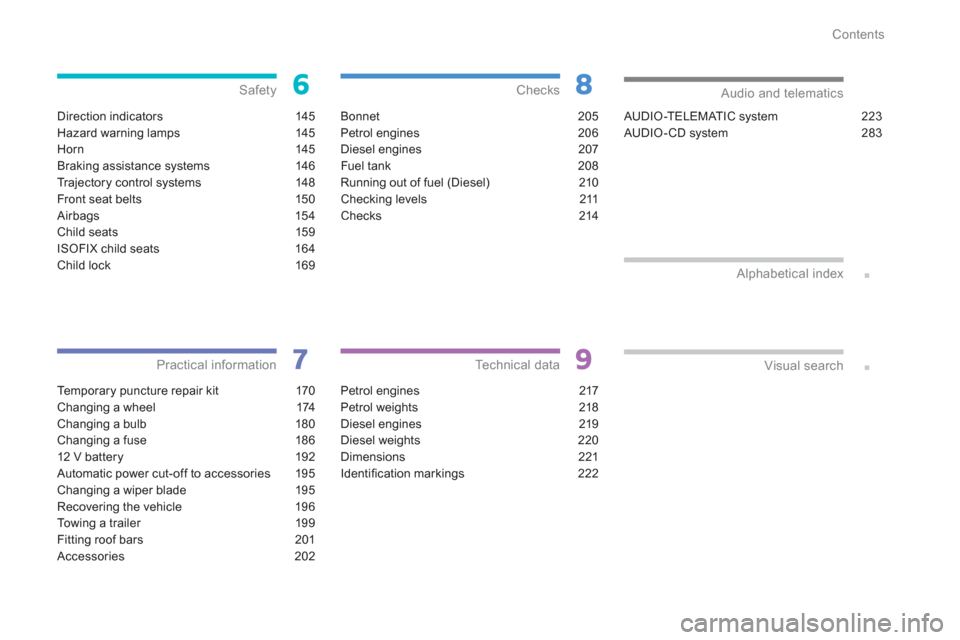
Contents
Direction indicators 145
Hazard warning lamps 145
Horn 145
Braking assistance systems 146
Tr ajectory control systems 148
Front seat belts 150
Airbags 154
Child seats 159
ISOFIX child seats 164
Child lock 169
Safety
Te m p o r a ry puncture repair kit 170
Changing a wheel 174
Changing a bulb 180
Changing a fuse 186
12 V battery 192
Automatic power cut-off to accessories 195
Changing a wiper blade 195
Recovering the vehicle 196
To w i ng a trailer 199
Fitting roof bars 201
Accessories 202
Practical information
Bonnet 205
Petrol engines 206
Diesel engines 207
Fuel tank 208
Running out of fuel (Diesel) 210
Checking levels 211
Checks 214
Checks
Petrol engines 217
Petrol weights 218
Diesel engines 219
Diesel weights 220
Dimensions 221
Identifi cation markings 222
Technical data
AUDIO-TELEMATIC system 223
AUDIO- CD system 283
Audio and telematics
Alphabetical index
Visual search
Page 161 of 332
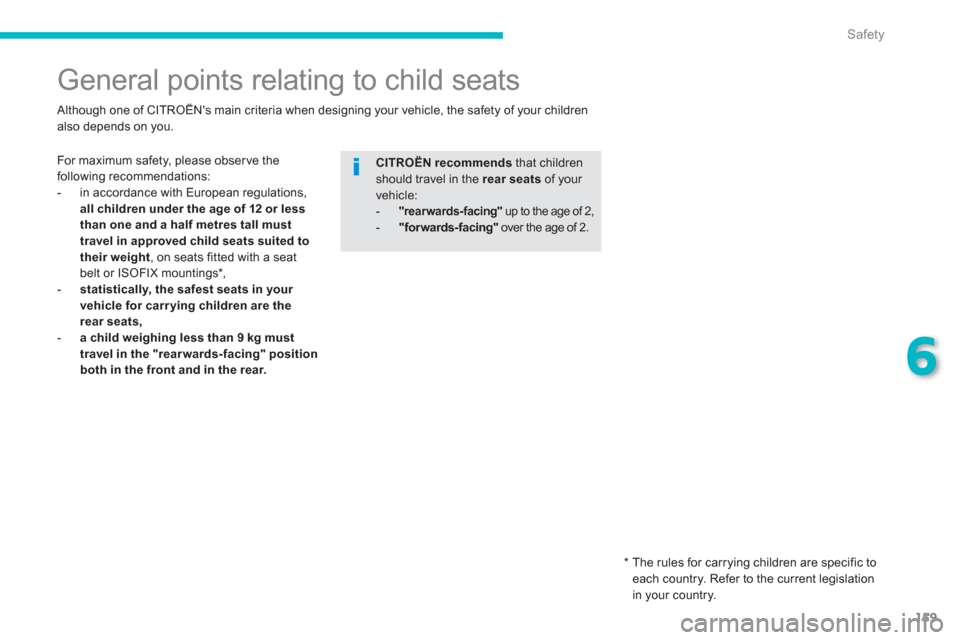
159
6
Safety
General points relating to child seats
For maximum safety, please obser ve the following recommendations:
- in accordance with European regulations,
all children under the age of 12 or less
than one and a half metres tall must
travel in a
pproved child seats suited to
their weight , on seats fitted with a seat
belt or ISOFIX mountings * ,-statistically, the safest seats in your
vehicle for carrying children are the rear seats, -
a child weighing less than 9 kg must
travel in the "rearwards-facing" position both in the front and in the rear.
CITROËN recommendsthat children should travel in the rear seats of your vehicle: -"rearwards-facing"
up to the age of 2, -
"forwards-facing"
over the age of 2.
Although one of CITROËN's main criteria when designing your vehicle, the safety of your children
also depends on you.
*
The rules for carrying children are specific to each country. Refer to the current legislation
in your country.
Page 165 of 332
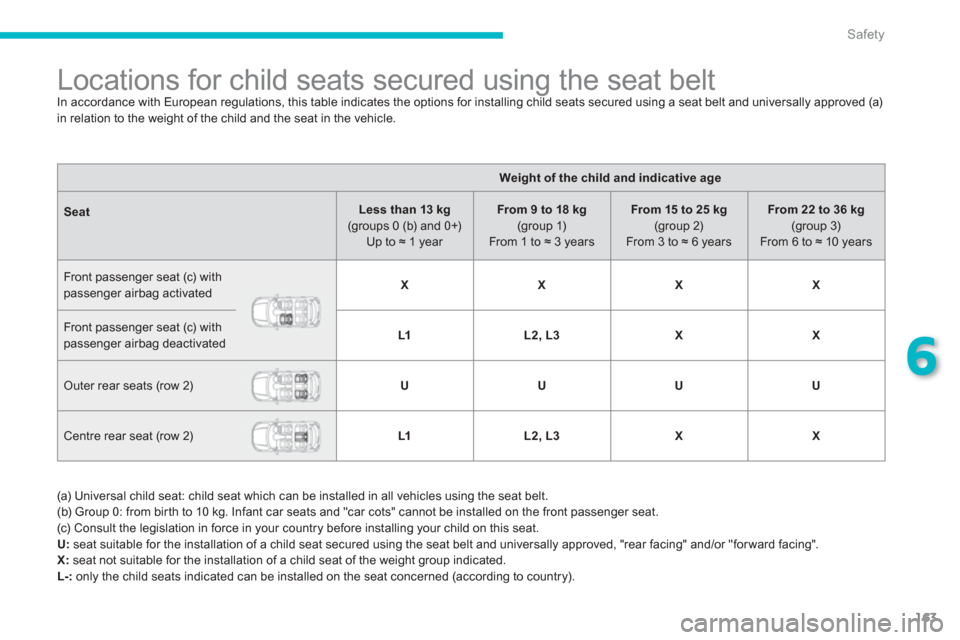
163
6
Safety
Locations for child seats secured using the seat belt
In accordance with European regulations, this table indicates the options for installing child seats secured using a seat belt and universally approved (a)
in relation to the weight of the child and the seat in the vehicle.
Seat
Weight of the child and indicative age
Less than 13 kg (groups 0 (b) and 0+)Up to ≈ 1 year
From 9 to 18 kg(group 1)From 1 to ≈ 3 years
From 15 to 25 kg
(group 2)From 3 to ≈ 6 years
From22 to 36 kg(group 3) From 6 to ≈ 10 years
Front passenger seat (c) withpassenger airbag activated XXXX
Front passenger seat (c) withpassenger airbag deactivated L1L2, L3XX
Outer rear seats (row 2)UUUU
Centre rear seat (row 2)L1L2, L3XX
(a) Universal child seat: child seat which can be installed in all vehicles using the seat belt.
(b) Group 0: from bir th to 10 kg. Infant car seats and "car cots" cannot be installed on the front passenger seat.
(c) Consult the legislation in force in your country before installing your child on this seat. U: seat suitable for the installation of a child seat secured using the seat belt and universally approved, "rear facing" and/or "for ward facing".
X:seat not suitable for the installation of a child seat of the weight group indicated.L-:
only the child seats indicated can be installed on the seat concerned (according to country).
Page 169 of 332
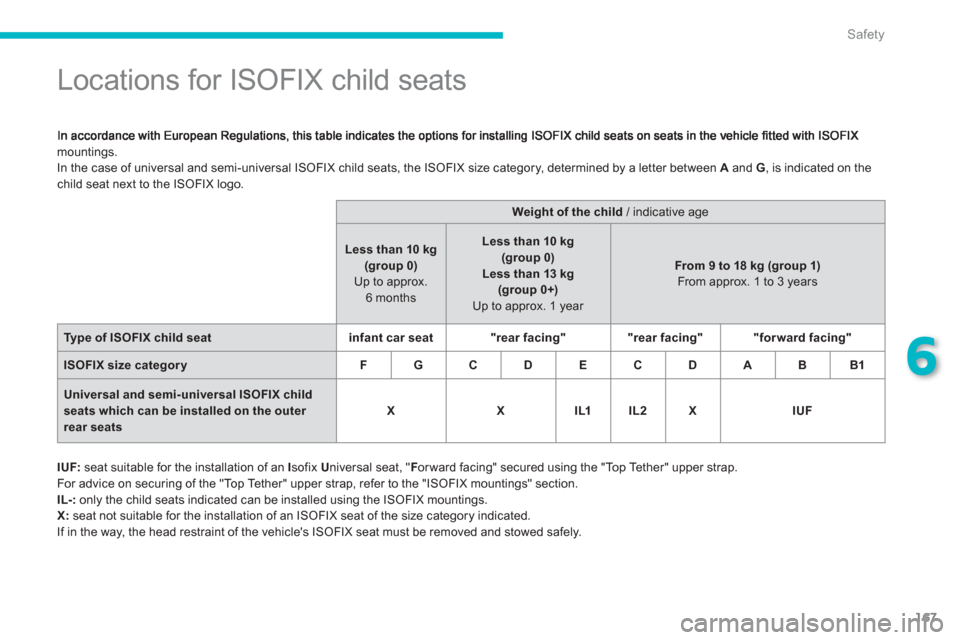
167
6
Safety
Locations for ISOFIX child seats
mountings.
In the case of universal and semi-universal ISOFIX child seats, the ISOFIX size category, determined by a letter between Aand G
, is indicated on the child seat next to the ISOFIX logo.
Weight of the child
/ indicative age
Less than 10 kg (group 0)Up to approx. 6 months
Less than 10 kg(group 0)
Less than13 kg (group 0+)Up to approx. 1 year
From 9 to 18 kg (group 1)From approx. 1 to 3 years
Type of ISOFIX child seatinfant car seat"rear facing""rear facing" "for ward facing"
ISOFIX size categoryFGCDECDABB1
Universal and semi-universal ISOFIX child seats which can be installed on the outer rear seatsXXIL1IL2XIUF
IUF:seat suitable for the installation of an Isofix U
niversal seat, "F
orward facing" secured using the "Top Tether" upper strap.
For advice on securing of the "Top Tether" upper strap, refer to the "ISOFIX mountings" section.IL-:only the child seats indicated can be installed using the ISOFIX mountings.
X:seat not suitable for the installation of an ISOFIX seat of the size category indicated.
If in the way, the head restraint of the vehicle's ISOFIX seat must be removed and stowed safely.
Page 198 of 332
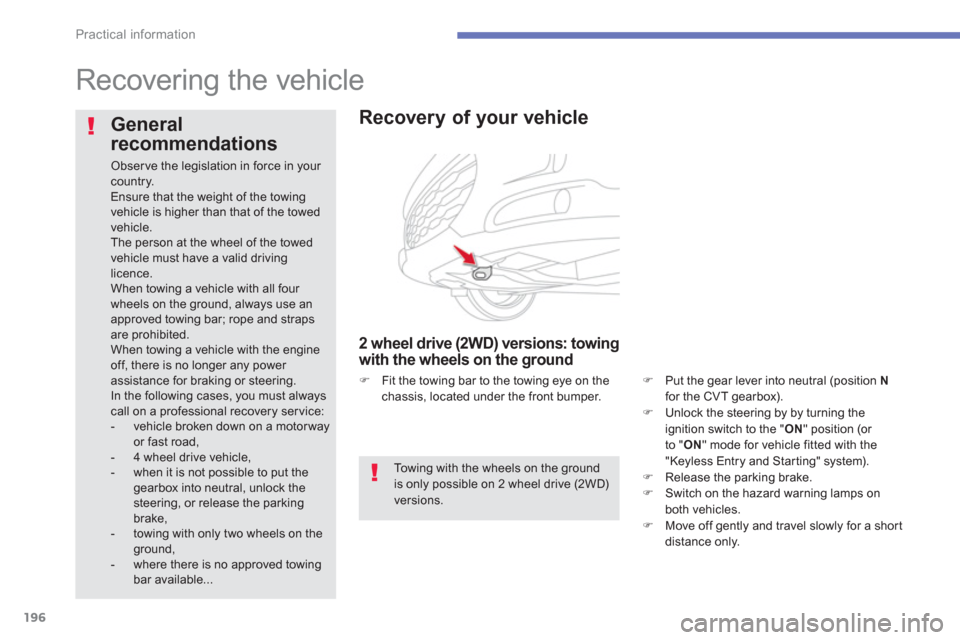
196
Practical information
Recovering the vehicle
General
recommendations
Obser ve the legislation in force in your country.
Ensure that the weight of the towing vehicle is higher than that of the towed vehicle.
The person at the wheel of the towed vehicle must have a valid drivinglicence.
When towing a vehicle with all four wheels on the ground, always use anapproved towing bar; rope and strapsare prohibited.
When towing a vehicle with the engine off, there is no longer any power assistance for braking or steering.
In the following cases, you must always call on a professional recovery service:
- vehicle broken down on a motor way or fast road,
- 4 wheel drive vehicle,
- when it is not possible to put thegearbox into neutral, unlock the steering, or release the parking brake,
- towing with only two wheels on the ground,
- where there is no approved towing bar available...
Towing with the wheels on the groundis only possible on 2 wheel drive (2WD) versions.
Recovery of your vehicle
2 wheel drive (2WD) versions: towingwith the wheels on the ground
�)Put the gear lever into neutral (position Nfor the CVT gearbox).�)Unlock the steering by by turning the
ignition switch to the " ON
" position (or
t
o " ON " mode for vehicle fitted with the
"Keyless Entry and Star ting" system). �)Release the parking brake. �)Switch on the hazard warning lamps on both vehicles.�)Move off gently and travel slowly for a shor t
distance only.
�) Fit the towing bar to the towing eye on thechassis, located under the front bumper.
Page 202 of 332
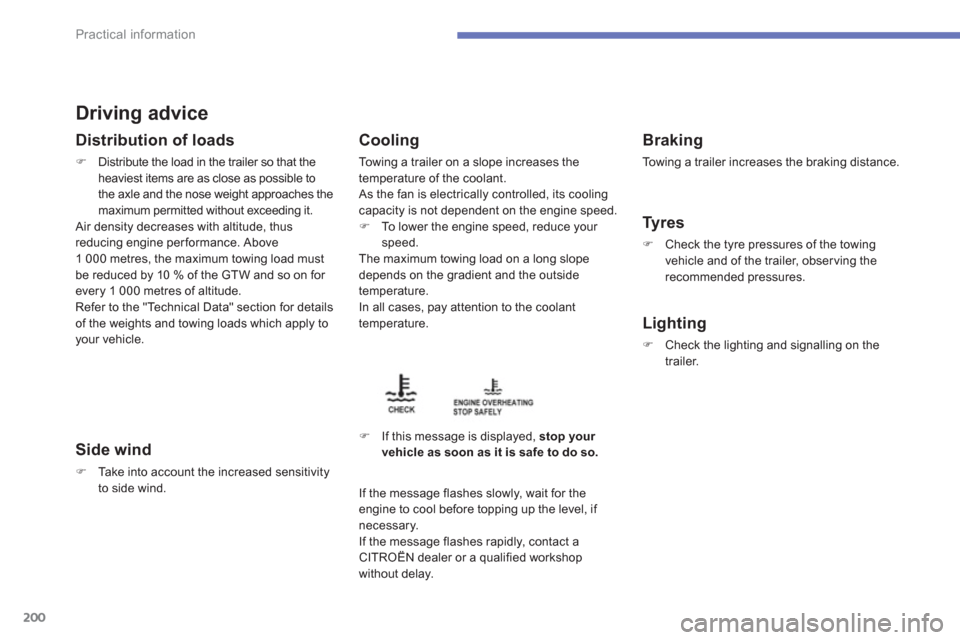
200
Practical information
Driving advice
Distribution of loads
�)Distribute the load in the trailer so that theheaviest items are as close as possible to
the axle and the nose weight approaches the maximum permitted without exceeding it.
Air density decreases with altitude, thus reducing engine performance. Above
1 000 metres, the maximum towing load must
be reduced by 10 % of the GTW and so on for every 1 000 metres of altitude.
Refer to the "Technical Data" section for details
of the weights and towing loads which apply to your vehicle.
Side wind
�)Take into account the increased sensitivity
to side wind.
Cooling
To w i ng a trailer on a slope increases the
temperature of the coolant.
As the fan is electricall
y controlled, its cooling capacity is not dependent on the engine speed.�)
To lower the engine speed, reduce your speed.
The maximum towing load on a long slope
depends on the gradient and the outside
tem
perature.
In all cases, pay attention to the coolant
temperature.
�) If this message is displayed, stop your vehicle as soon as it is safe to do so.
Braking
To w i ng a trailer increases the braking distance.
Tyres
�)Check the tyre pressures of the towingvehicle and of the trailer, obser ving the recommended pressures.
Lighting
�)Check the lighting and signalling on the
trailer.
I
f the message flashes slowly, wait for the engine to cool before topping up the level, if necessary.
If the messa
ge flashes rapidly, contact a CITROËN dealer or a qualified workshop
without delay.
Page 203 of 332
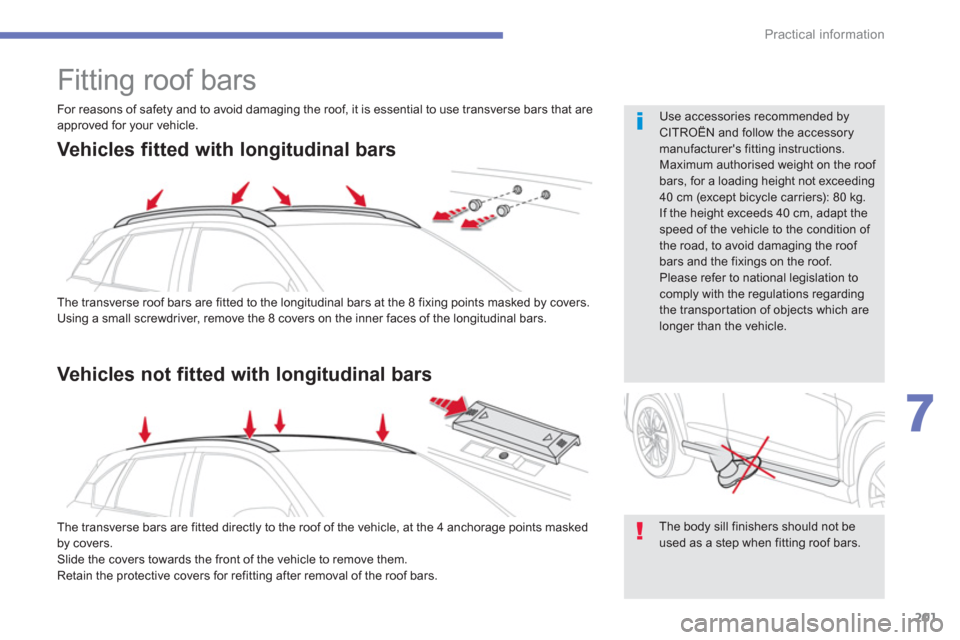
201
7
Practical information
Fitting roof bars
The body sill finishers should not be used as a step when fitting roof bars.
Use accessories recommended byCITROËN and follow the accessorymanufacturer's fitting instructions.
Maximum authorised weight on the roof bars, for a loading height not exceeding40 cm (except bicycle carriers): 80 kg.
If the height exceeds 40 cm, adapt the speed of the vehicle to the condition of the road, to avoid damaging the roof bars and the fixings on the roof.
Please refer to national legislation tocomply with the regulations regardingthe transpor tation of objects which arelonger than the vehicle. The transverse roof bars are fitted to the lon
gitudinal bars at the 8 fixing points masked by covers.
Using a small screwdriver, remove the 8 covers on the inner faces of the longitudinal bars.
The transverse bars are fitted directl
y to the roof of the vehicle, at the 4 anchorage points masked
by covers.
Slide the covers towards the front of the vehicle to remove them.
Retain the protective covers for refitting after removal of the roof bars.
Vehicles fitted with longitudinal bars
Vehicles not fitted with longitudinal bars
For reasons of safety and to avoid damaging the roof, it is essential to use transverse bars that are
approved for your vehicle.
Page 220 of 332
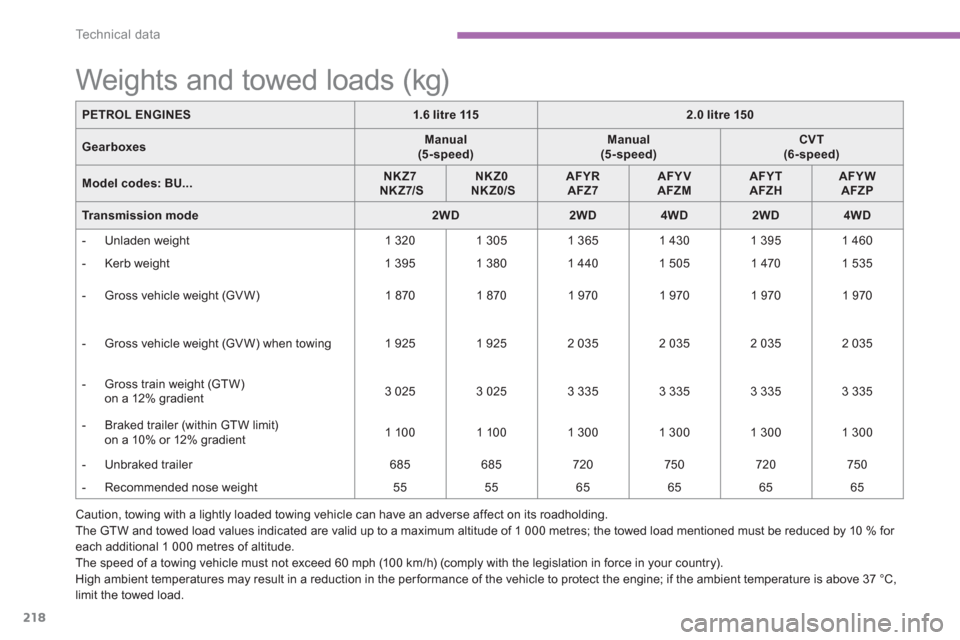
218
Technical data
Caution, towing with a lightly loaded towing vehicle can have an adverse affect on its roadholding.
The GTW and towed load values indicated are valid up to a maximum altitude of 1 000 metres; the towed load mentioned must be reduced by 10 % for each additional 1 000 metres of altitude.
The speed of a towing vehicle must not exceed 60 mph (10 0 km/h) (comply with the legislation in force in your country).
High ambient temperatures may result in a reduction in the performance of the vehicle to protect the engine; if the ambient temperature is above 37 °C, limit the towed load.
PETROL ENGINES1.6 litre 1152.0 litre 150
GearboxesManual (5-speed)Manual(5-speed)CVT (6-speed)
Model codes:BU...NKZ7NKZ7/SNKZ0NKZ0/SAFYR AFZ7AFYVAFZMAFYT AFZHAFYWAFZP
Transmission mode2WD2WD4WD2WD4WD
- Unladen weight 1 320
1 305 1 365 1 430
1 3951 460
- Kerb weight 1 395
1 380 1 440
1 505 1 470
1 535
-
Gross vehicle weight (GVW)
1 870
1 870
1 970
1 970
1 9701 970
- Gross vehicle weight (GVW) when towing
1 9251 925
2 035
2 0352 0352 035
-
Gross train weight (GTW)
on a 12% gradient3 025 3 025
3 3353 335
3 335
3 335
- Braked trailer
(within GTW limit) on a 10% or 12% gradient
1 100
1 1001 3001 300
1 300
1 300
-
Unbraked trailer
685
685720
750
720
750
- Recommended nose weight
55 55
65 65 65
65
Weights and towed loads (kg)
Page 222 of 332
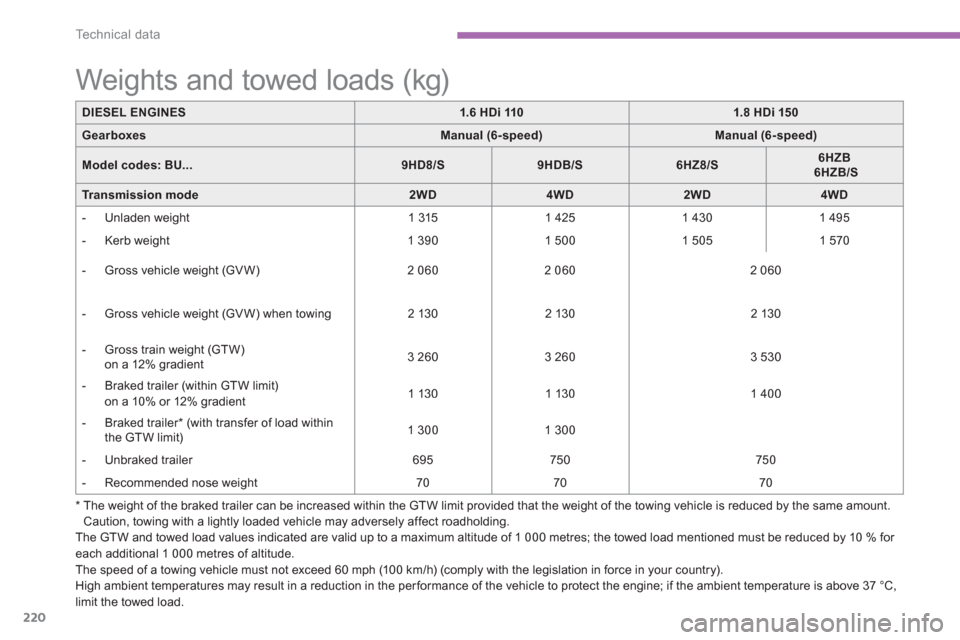
220
Technical data
The GTW and towed load values indicated are valid up to a maximum altitude of 1 000 metres; the towed load mentioned must be reduced by 10 % for each additional 1 000 metres of altitude.
The speed of a towing vehicle must not exceed 60 mph (10 0 km/h) (comply with the legislation in force in your country).
Hi
gh ambient temperatures may result in a reduction in the per formance of the vehicle to protect the engine; if the ambient temperature is above 37 °C,
limit the towed load.
DIESEL ENGINES1.6 HDi 1101.8 HDi 150
GearboxesManual (6-speed)Manual (6-speed)
Model codes:BU...9HD8/S9HDB/S6HZ8/S6HZB6HZB/S
Transmissionmode2WD4WD2WD4WD
- Unladen weight
1 315
1 425
1 430
1 495
- Kerb weight 1 390
1 500
1 505 1 570
- Gross vehicle weight (GV W)
2 060
2 060
2 060
- Gross vehicle weight (GV W) when towing
2 130
2 130
2 130
-
Gross train weight (GTW)
on a 12% gradient 3 260
3 260
3 530
- Braked trailer
(within GTW limit)on a 10% or 12% gradient 1 130 1 130
1 400
- Braked trailer *
(with transfer of load within
the GTW limit)
1 300 1 300
-
Unbraked trailer
695
750
750
- Recommended nose weight
70
70
70
Weights and towed loads (kg)
*
The weight of the braked trailer can be increased within the GTW limit provided that the weight of the towing vehicle is reduced by the same amount.
Caution, towing with a lightly loaded vehicle may adversely affect roadholding.
Page 224 of 332
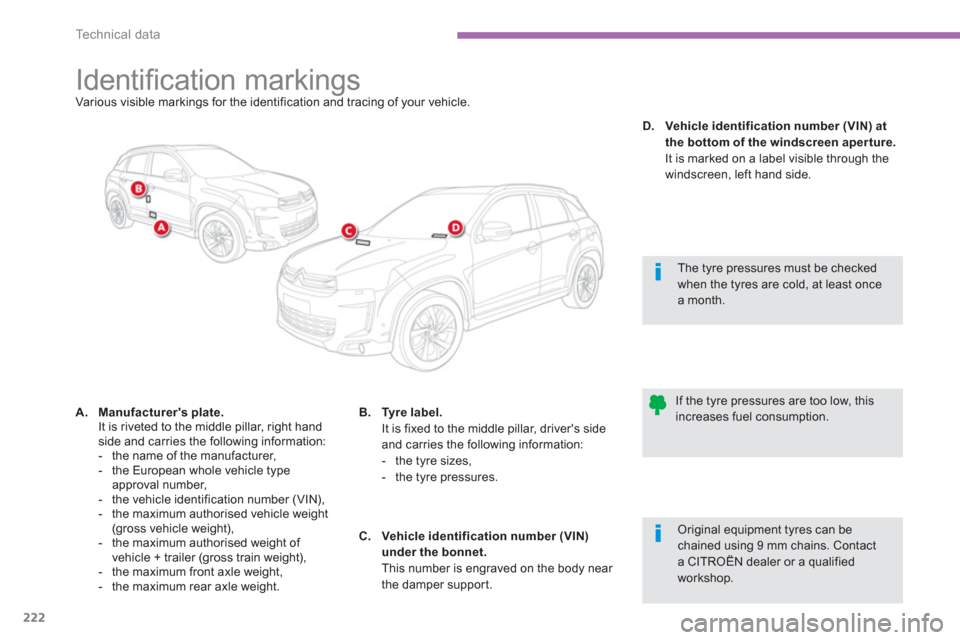
222
Technical data
Identifi cation markings Various visible markings for the identification and tracing of your vehicle.
A.Manufacturer's plate.It is riveted to the middle pillar, right handside and carries the following information:
- the name of the manufacturer,
- the European whole vehicle typeapproval number,
- the vehicle identification number (VIN),
- the maximum authorised vehicle weight(gross vehicle weight),
- the maximum authorised weight of
vehicle + trailer (gross train weight),
- the maximum front axle weight,
- the maximum rear axle weight.
The tyre pressures must be checked when the tyres are cold, at least oncea month.
If the tyre pressures are too low, thisincreases fuel consumption.
B.Tyre label. It is fixed to the middle pillar, driver's side
and carries the
following information:
- the tyre sizes,
- the tyre pressures.
D.Vehicle identification number (VIN) at
the bottom of the windscreen aperture.
It is marked on a label visible through the
windscreen, left hand side.
Original equipment tyres can be
chained using 9 mm chains. Contact a CITROËN dealer or a qualifiedworkshop.
C.Vehicle identification number (VIN) under the bonnet. This number is engraved on the body near
the damper support.